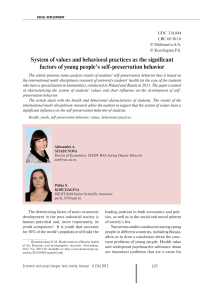System of values and behavioral practices as the significant factors of young people's self-preservation behavior
Автор: Shabunova Aleksandra Anatolyevna, Korchagina Polina Sergeyevna
Журнал: Economic and Social Changes: Facts, Trends, Forecast @volnc-esc-en
Рубрика: Social development
Статья в выпуске: 6 (24) т.5, 2012 года.
Бесплатный доступ
The article presents some analysis results of students’ self-preservation behavior that is based on the international multi-disciplinary research of university students’ health (in the case of the students who have a specialization in humanities), conducted in Poland and Russia in 2011. The paper is aimed at characterizing the system of students’ values and their influence on the development of self- preservation behavior. The article deals with the health and behavioral characteristics of students. The results of the international multi-disciplinary research allow the authors to suggest that the system of values have a significant influence on the self-preservation behavior of students.
Health, youth, self-preservation behavior, values, behavioral practices
Короткий адрес: https://sciup.org/147223403
IDR: 147223403 | УДК: 314.044
Текст научной статьи System of values and behavioral practices as the significant factors of young people's self-preservation behavior
The determining factor of socio-economic development in the post-industrial society is human potential and, more importantly, its youth component1. It is youth that accounts for 30% of the world’s population will take the leading position in both economics and politics, as well as in the social and moral spheres of society’s live.
Numerous studies conducted among young people in different countries, including Russia, allow us to draw a conclusion about the common problems of young people. Health value and widespread psychoactive substance abuse are important problems that are a cause for concern to the younger generation. However, the health and well-being of this age group are rarely considered in the comparative European studies. It is also difficult to find national medical and sanitary information about this age group. At the same time, the foundations of health formation in consideration of socioeconomic, environmental, behavioral and other factors are laid not only in childhood but also in the period of transition from childhood to adult life.
There are the following trends that are common to young people in Europe2.
– Premature mortality .
About 30,500 people aged from 15 to 24 die in the European Union Member States every year, including 23 000 men and 7500 women. Road traffic accidents are the main cause of mortality at young adult ages (about 10 000 men and 2000 women per year); every tenth premature death is a result of suicide. There are 20 incidents of mortality at young adult ages due to traffic injuries per 100,000 people in Russia.
– Rising life expectancy (LE - integral indicator of health) .
Life expectancy for the population aged 15 has increased by 2 years (from 63.2 to 65.3) in the EU countries over the period from 2000 to 2010 and from 51.9 to 54.7 in 2009 in Russia. At the same time, it is necessary to take into account the increase in the prevalence of such chronic pathologies as asthma, allergies, diabetes and obesity.
– Young people believe their health is good .
However, about a quarter of the population in this age group suffers from psychosomatic illnesses.
– Increasing differences in the social and cultural determinants of health between the states and within the countries .
The following characteristics of lifestyle are worth noticing:
-
■ Prevalence of tobacco consumption . There are 50 – 80% of teens aged under 15 who have tried smoking in Europe; 30% of young people aged 15 – 28 smoke daily. There is a tendency to increase tobacco consumption by young people and early daily smoking trend. In Russia, 40% of men and 7% of girls aged 15 – 19 smoke; on average, they smoke 12 and 7 cigarettes per day, respectively (in absolute numbers: there are more than 3 million smokers among teens – 2.5 million men and 0.5 million girls).
-
■ People begin to use alcohol regularly at a younger age. Young men drink more often than girls, although the gender differences are being reduced. Excessive alcohol consumption is becoming more common among young people in all the countries. According to Rospotrebnadzor, in Russia 33% of boys and 20% girls consumed alcohol daily in 2011. The peak of mass taking up alcohol habits can be observed in the group of teens aged 14 – 15. Alcoholism diseases of teens increased from 18.1 to 20.7 incidents per 100,000 people in 2011 as compared with 2010.
The results of studies show that a significant share of young people have poor physical activity to maintain health.
This article presents some analysis results of students’ self-preservation behavior that is based on the international multi-disciplinary research of university students’ health (in the case of the students with a specialization in humanities), conducted in Poland and Russia in 20113.
The paper is aimed at characterizing the system of students’ values and their influence on the development of self-preservation behavior.
Self-preservation behavior is considered as a system of actions and relations that are aimed at preserving and maintaining health as long as life endures, as well as at extending life span4. Health self-appraisal and health values are one of the main conditions of health formation.
Subjective characteristics of health received due to sociological surveys are used increasingly by domestic and foreign scholars5. Despite some limitations of this method, it has been recognized as reliable enough and recommended by the World Health Organization to monitor public health within the countries and for cross-country comparisons. Health self-rating reflects in most cases the true level of public health6. Therefore, the use of sociological information about population health is fully justified and useful as an additional tool to assess the public health, as well as a “starting point” in characterizing its different aspects.
Turning to the results of the study, we note that the majority of students (90% in Vologda and 92% in Lublin, fig. 1 ) rated their health as excellent and normal; only a small share of the respondents pointed out the presence of chronic diseases (10% and 8%, respectively).
People have different attitudes towards their health. Health in itself is value for some of them; it is required for other people to achieve, first of all, the concrete aims (significant working results, career development, earning money, etc.). The importance of health for each person determines his/her activity for his/her own health. People form their behavior based on this. Self-rating has a dual function – an indicator and regulator of behavior. There are strong correlations between health self-rating and the main leading factors of it7. Self-rating assumes full information value only in the connection with considering it as a determinant of behavior in regard to the factors that contribute to maintaining and improving health or the threats to physical health and mental well-being8.
73% of respondents among students consider their health as an important value in their life; 87% of respondent make aware of their responsibility for health support; 30% of respondents believe that they have good health and they cannot take care of it9.
The respondents who rate their health as “excellent” not only “are glad to have good health” but they agree with the statement: “My health depends on me” (fig. 2) more often than the respondents from other groups. The comparison of value characteristics and health self-rating identifies the group of careless young people who do not take care of their health even if they have chronic illness.
Identifying the important negative factors affecting their health, most students pointed out poor environmental conditions (Vologda – 76%, Lublin – 73%, tab. 1 ). But they were unanimous only in the assessment of this factor.
Students from Vologda’s universities pointed out the impact of learning environment more often than their counterparts from Poland (25% and 15%, respectively). Polish students chose harmful habits among the most important factors more often than the students from Vologda (53% and 39%, respectively) and poor living conditions (23% and 10%, respectively).
Figure 1. Answers to the question: “How would you rate your health?” (in % to the number of respondents)
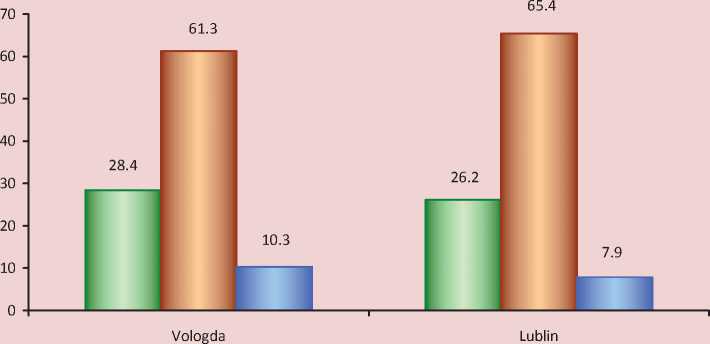
□ Excellent health (have no diseases)
□ Good health (have no chronic diseases)
□ Poor health (have chronic diseases)
Figure 2. Health saving attitudes of the students answering the question: “How do you rate your health?”, Vologda (points, point average on a five-grade scale)
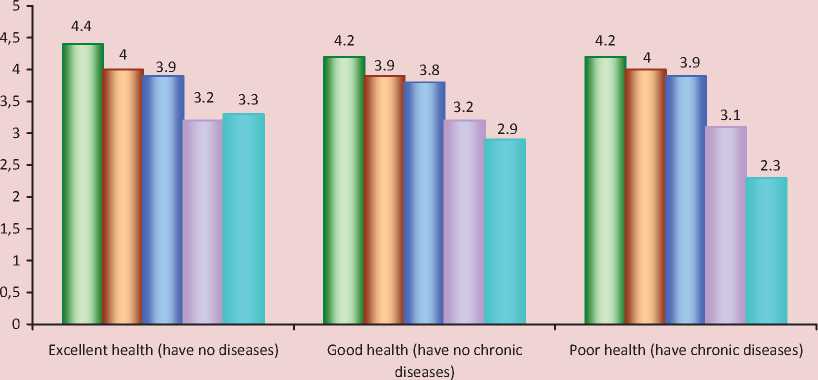
□ My health depends on me
□ Health is an important value in my life
□ I feel responsible for my health that was given to me at birth
□ I will be anxious about my health in future
□ I am glad to have good health, so I don’t have to take care of it
Table 1. Answers to the question: “Will you list the factors that have a negative affect on your health?” (in % to the number of respondents)
|
Factors |
Study, on average |
Vologda |
Lublin |
|
Poor environment |
74.6 |
75.8 |
73.4 |
|
Unhealthy lifestyle (harmful habits) |
45.9 |
38.9 |
52.8 |
|
Learning environment |
20.2 |
25.3 |
15.0 |
|
Domestic life (living) conditions |
16.4 |
9.8 |
22.9 |
|
Other |
15.0 |
14.1 |
15.9 |
Modern people often have a need for health, but it is interpreted by them with regard to particular circumstances, and it is not implemented in their health10.
The examples confirming the acuteness of the problem can be found in the current study. Thus, for example, 24% of students think smoking is a bad habit, but at the same time they smoke (23% of smokers in Vologda and 24% in Lublin); 26% of respondents allow the consumption of beer and other alcoholic drinks, even without cause (15% and 36%, respectively); 10% of respondents have used drugs one or more times (6% and 13%, respectively).
Despite visible differences in values and ideas about the factors hampering the preservation of health, behavioral practices of Polish and Russian students are very similar11. The most popular health-saving activities include active outdoor recreation (64% of the students in Vologda, 54% – in Lublin) and sports (41% of young people in each city). The share of students who do morning exercises (15% and 11% respectively) and go to fitness rooms (21% and 8%, respectively) is lower.
Significant academic loads and the prevalence of behavioral risk of health deterioration are the causes of various diseases of young people during their training. 11% of students from Vologda and 25% of Polish students almost always feel tiredness after their classes; about 70% of respondents “are very tired sometimes”. The study shows that 70% of students from Vologda and 60% of Polish students have health abnormalities acquired during the training period (tab. 2).
However, the students who have faults in posture seldom spend their free time walking (on average, 40% of respondents who have scoliosis vs. 46% of respondents with no diseases; tab. 3 ), and they more often enjoy time in playing computer or watching TV (on average, 33 % vs. 23%, respectively). At the same time, the students suffering from myopia sit at a computer more often than the respondents who have strong eyes (on average, 29% versus 23%). The revealed relationships characterize the students from both countries, and they confirm the important role of behavioral practices in preserving and maintaining the health and underrating of students’ efforts in preserving it.
Value orientations to long and healthy life are important factors that determine the demographic behavior and influence the life of man 12. The analysis of prolonged health guidelines shows that about a third of respondents believe that their health will be better than the health of their grandparents (fig. 3) . However, only 15 – 16% of respondents rate the health of their grandparents as good and 1 – 2% – as excellent.
12 Encyclopedic dictionary of sociology: English, Russian, French and Czech. Ed. by G.V. Osipov. Moscow: INFRANORM, 1998. P. 224.
Table 2. Answers to the question: “Will you point out the disease that you have acquired during the training period?” (in % to the number of respondents*)
|
Type of disease |
Vologda |
Lublin |
|
Have no diseases during the training period |
27.1 |
40.2 |
|
Nervous and mental diseases |
46.3 |
33.2 |
|
Myopia |
30.0 |
30.4 |
|
Scoliosis |
25.5 |
14.5 |
|
Gastrointestinal diseases |
20.6 |
22.0 |
|
Diseases of the respiratory system |
4.7 |
7.0 |
|
Heart diseases |
4.0 |
8.4 |
|
Other |
4.3 |
8.4 |
|
* It was possible to give some answers to the question, so the sum can exceed 100%. |
||
Table 3. Relationship between the form of students’ leisure activity and their health (in % to the number of respondents)
|
Form of leisure activity |
Diseases acquired during the training period |
||||||||
|
Vologda |
Lublin |
Study, on average |
|||||||
|
о |
о со |
5 |
о |
о со |
5 |
о |
о со |
5 |
|
|
Walking with friends |
49.6 |
31 |
35.6 |
42.4 |
48.4 |
48.4 |
46.0 |
39.7 |
42.0 |
|
Sitting at a computer at home |
27.4 |
39.8 |
38.6 |
18.8 |
25.8 |
18.8 |
23.1 |
32.8 |
28.7 |
|
Watching TV at home |
4.3 |
9.7 |
7.6 |
11.8 |
19.4 |
10.9 |
8.1 |
14.6 |
9.3 |
|
Reading at home |
3.4 |
7.1 |
9.8 |
10.6 |
3.2 |
10.9 |
7.0 |
5.2 |
10.4 |
|
Hobby |
15.4 |
12.4 |
8.3 |
16.5 |
3.2 |
10.9 |
16.0 |
7.8 |
9.6 |
Figure 3. Answers to the question: “What will your health be when you are under the age of your grandparents?” (in % to the number of respondents)
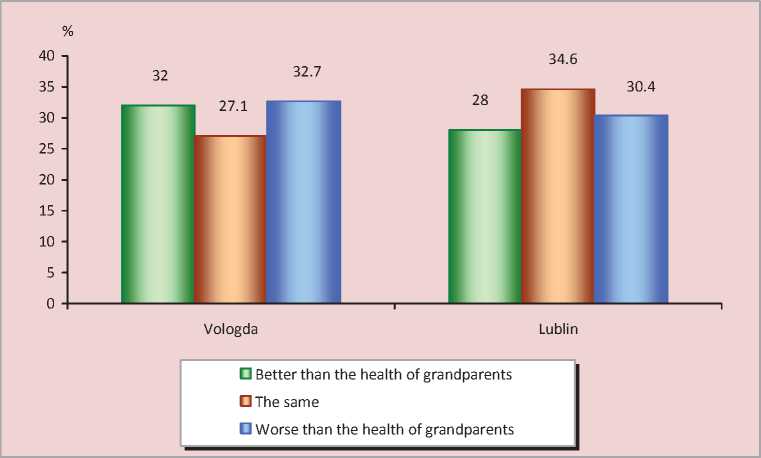
Figure 4. Health saving attitudes of the students answering the question: “What will your health be when you are under the age of your grandparents?”, Vologda (points, point average on a five-grade scale)
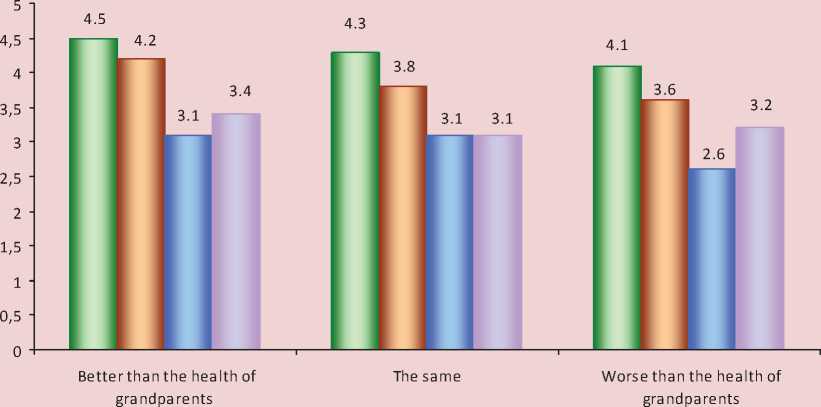
□ My hea lth depends on me
□ I feel responsible for my hea lth that was given to me at birth
□ I am glad to have good hea lth, so I cannot take care of it
: I will be anxious about my hea lth in future
The study has found that students’ orientation to healthy longevity is associated with the realization of their own responsibility for health. The deeper the students realize their role in preserving health, the more they can count on the fact that their health will be better than the health of their grandparents when they are pensioners (fig. 4) .
In consideration of the things mentioned above, it should be noted that students have high value orientations to health, but they are not always supported by students’ personal responsibility for preserving health and their active actions aimed at improving the physical and psychological well-being. Polish students understand the influence of subjective factors on their own health more than Russian students, and they try to have such a lifestyle that would not harm their health and contribute to their educational productivity. Young people from both countries consider their health as never-ending welfare and they do not think that it is necessary to make some effort to keep it from earliest infancy.
The development of healthy habits of today’s youth will ensure the health of future specialists and managers, young families and children, the health of the nation on the whole. However, students have an internal base in the form of a system of health saving attitudes to develop their self-preservation behavior, but it is necessary to strengthen the mechanisms that stimulate and promote implementing healthpreservation behavioral practices.
Список литературы System of values and behavioral practices as the significant factors of young people's self-preservation behavior
- Antonov А.I. Microsociology of family (methodology of the study of structures and processes). Мoscow: Nota Bene, 1998. 360 p.
- Vvedenskaya I.I., Vvedenskaya Е.S., Shilova L.S. Self-rating of health as an indicator of the self-preservation behavior of the elderly persons. Problems of social hygiene, public health and medical history. 1999. No. 5. P. 12-15.
- Zhuravleva I.V. Public attitudes to health. Мoscow, 1993. P. 97.
- Kovaleva A.A. Self-preservation behavior of the population: sociological analysis. Proceedings of the XV International conference of students, postgraduate students and young scientists “Lomonosov”. Ed. by I.A. Aleshkovskiy, P.N. Kostylev, A.I. Andreyev. Moscow, 2008. Available at: http://lomonosov.econ.msu.ru/2008/19_22.pdf
- Krasnova P.S. Self-preservation behavior of youth (in the case of the students attending the humanities departments of higher educational establishments). Problems of Development of Territories. Vologda: ISEDT RAS, 2012. No. 3 (59). P. 93-98.
- Rimashevskaya N.M. Modernization of Russia: health of the Russians and demographic situation. Demoskop. 2012. No. 509-510. Available at: http://www.demoscope.ru/weekly/2012/0509/nauka02.php
- Encyclopedic dictionary of sociology: English, Russian, French and Czech. Ed. by G.V. Osipov. Moscow: INFRA-NORM, 1998. P. 224.
- Shabunova А.А., Krasnova P.S. Alcohol overconsumption as a form of self-distractive behavior of population. In the world of scientific discoveries. 2012. No. 6 (30). P. 78-100.
- Buck C.N., Aucoin J.B.//J. Gerontol. 1975. Vol. 30. P. 73-76.

